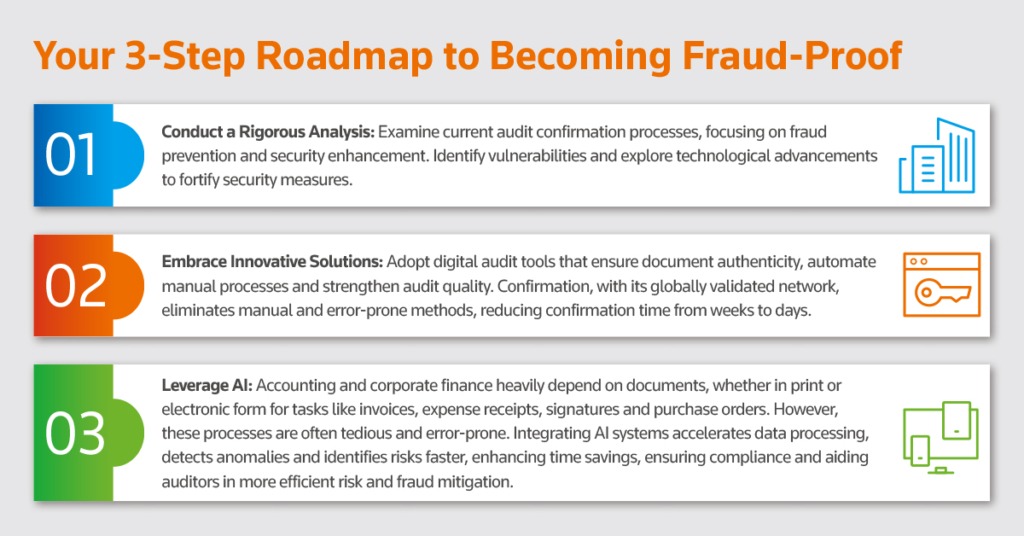
The Digital Imperative: An Audit Leader’s 3-Step Roadmap for Fraud Resilience
- 5 minutes read
Regulation is on everyone’s mind as a wave of notable audit scandals and security breaches rocked the US and EU. These events brought to light the vulnerabilities in traditional audit processes. They’ve also highlighted the imperative for a paradigm shift towards digitisation and advanced technology adoption across the globe.
The simple fact of the matter is: Auditors need cutting-edge technology solutions to navigate a rapidly evolving risk and fraud landscape. Not only might they soon be a regulatory requirement, but recent estimates suggest that organisations lose approximately 5 per cent of revenue to internal fraud each year.
While that may not seem like much, it represents more than AU$6.68 trillion globally. This substantial financial setback not only impacts immediate profitability but also casts a shadow over long-term growth and strategic investments.
The Call for Technological Solutions
Scandals like the Commerzialbank Mattersburg in Austria, the Wirecard collapse in Germany and Enron in the US have laid bare the weaknesses in traditional audit methods. These incidents underscore the pressing need for auditors to embrace technology solutions.
Let’s take a closer look:
- Commerzialbank Mattersburg scandal: Nearly AU$745 million went missing at Commerzialbank Mattersburg, a commercial bank in Austria. The bank long reported that it had large balances of 40 to 60 million Euros each with five other Austrian banks. When examiners called those banks looking for the money, it didn’t exist.
- Wirecard collapse: In what amounts to the largest accounting fraud in European post-war history, the collapse of German payment processor Wirecard shocked the corporate world and grabbed headlines globally.
When the company admitted AU$2.95 billion was not only missing from its balance sheet, but didn’t exist; the fallout destabilised banks, creditors, wealth funds, firms using Wirecard’s services and customers all over the world who have been unable to access capital.
- Enron Scandal: In the early 2000s, Enron, a Houston-based energy company, orchestrated one of the largest corporate fraud scandals in US history. Employing complex accounting tactics, Enron distorted financial records to project a misleading image of success.
The use of off-balance-sheet entities, known as SPEs, concealed significant debt and inflated profits, leading to Enron’s bankruptcy in December 2001. The aftermath included the dissolution of Arthur Andersen, a major audit firm, and prompted regulatory changes such as the Sarbanes-Oxley Act in 2002 to prevent future accounting scandals.
The Global Impact of Fraud
The global impact of fraud extends beyond these scandals, accelerating imminent changes to accounting legislation worldwide. Several large-scale bank confirmation scams, including Parmalat, Peregrin Financial and that of fund owner James Shepherd, highlight the vulnerability of relying on paper in the audit confirmation trail.
Businesses also face unparalleled scrutiny from regulatory bodies and the general public. Fines issued by the PCAOB, a globally observed US regulatory body, underscore the necessity for businesses to transform processes to align with the evolving regulatory landscape.
The financial consequences, including fines, penalties and settlement costs, are just the tip of the iceberg though. The true cost of fraud and non-compliance manifests in business disruption, productivity loss and reputational damage. Each of these influences organisational longevity and financial recovery tied to market perceptions and trust.
Setting The Standard For Security
It’s clear – dated audit confirmation methods can’t protect your clients’ data and are vulnerable to fraud. The Thomson Reuters® Confirmation digital platform offers a secure alternative, ensuring end-to-end protection for sensitive information, limiting risk for auditors and their clients.
With Confirmation:
- Every party is validated: Before using the platform, auditors and bankers’ business details are verified, reducing fraud risk. Only authorised signers can electronically sign confirmations, creating an electronic confirmation trail.
- End-to-end security is baked in: Using AES-256 encryption, the digital platform protects signatures, attachments and completed confirmation documents, exceeding industry standards. Thomson Reuters Confirmation undergoes two Service Organisation Control (SOC) exams annually, ensuring compliance with security measures.
- Fraud prevention is a natural byproduct: The platform has successfully uncovered billions of dollars in fraud, limiting data loss possibilities and ensuring data integrity. Thomson Reuters Confirmation accelerates confirmation processes, allowing staff to reach the truth faster, in days rather than weeks – and at a fraction of the cost.
By eliminating the pain points of the traditional audit confirmation process, Confirmation makes it more pleasant for everyone – auditors, clients and banks included. Auditors are more productive and less stressed. Clients appreciate the ease of authorising confirmations online and having them completed faster. And banks benefit from the increased efficiency. With Confirmation, it’s a win (win win) across the board.

Connect with us today for a confidential discussion on how Confirmation can empower your firm to navigate the evolving landscape of audit and fraud prevention effectively.